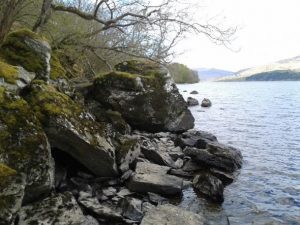Ecological Surveys in Upland Habitat
Introduction
Two upland areas were selected for planting a mixture of native trees and commercial plantation; the two sites totalled 730ha and were located within approximately 2.5km of one another.
In late 2016 Echoes Ecology Ltd completed a Preliminary Ecological Appraisal at each site and in 2017 Echoes carried out otter (Lutra lutra), water vole (Arvicola amphibius) and breeding bird surveys.
Preliminary Ecological Appraisal (PEA)
Both areas contained a variety of habitats, which included acid grassland, marshy grassland, blanket bog, acid and basic upland flushes, bracken (Pteridium aquilinum) dominated areas, and dry and wet heath. Locally important plant species such as yellow saxifrage (Saxifraga aizoides) and heather (Calluna vulgaris) were recorded along with the carnivorous plants common butterwort (Pinguicula vulgaris) and round-leaved sundew (Drosera rotundifolia).

Otter and Water Vole Survey
While the water courses were suboptimal for use by water vole due to their rocky nature which created unsuitable burrowing substrate, otter signs were abundant. A total of 13 resting places were found; a rocky section along the edge of a Loch measuring 2.5km in length contained 10 otter resting sites among the boulders.

Breeding Birds Survey
An adapted Brown and Shepherd methodology was used to survey for breeding birds within the open upland habitat and black grouse (Tetrao tetrix) surveys were carried out.
A total of 53 species were recorded across the two sites and included the Schedule 1 species golden eagle (Aquila chrysaetos) and red kite (Milvus milvus), and the red-listed species black grouse, curlew (Numenius arquata), woodcock (Scolopax rusticola), cuckoo (Cuculus canorus), skylark (Alauda arvensis), wood warbler (Phylloscopus sibilatrix), song thrush (Turdus philomelos), spotted flycatcher (Muscicapa striata), whinchat (Saxicola rubetra), grey wagtail (Motacilla cinerea), tree pipit (Anthus trivialis), and lesser redpoll (Acanthis cabaret).

Other Species
During the breeding bird walkover surveys, an oil beetle (Meloe sp.) was encountered in two locations. These insects are in decline throughout Britain due to changes in countryside management practices.

Outcomes
Although the botanical list was restricted as the PEA was completed outwith the flowering season, it still allowed for the early identification of potential GWDTEs (e.g. wet acid grassland, marshy grassland and flushes) and peatlands (blanket bog), both of which are important considerations when preparing planting plans. It also enabled an impact assessment to be completed for designated sites and the formulation of appropriate avoidance measures.
The suite of surveys allowed Echoes to identify the potential impacts of the proposed planting on different aspects of the ecology within the site and the otter survey highlighted the need for a SNH Habitats Regulations licence. The data from the surveys was used to produce comprehensive reports and mitigation strategies which will minimise the predicted impacts and enhance the biodiversity within the site.